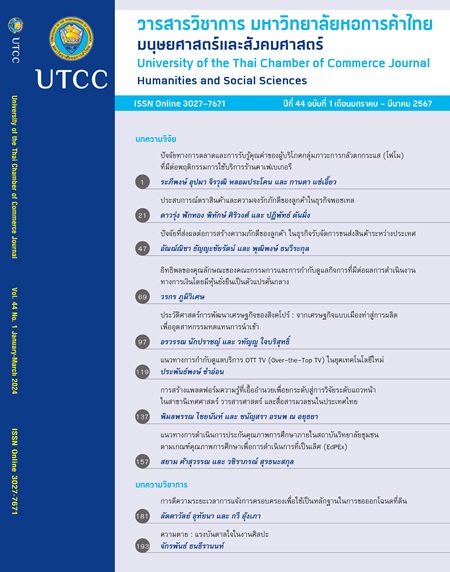Regulation of OTT TV (Over-the-Top TV) in an Era of New Technologies
Main Article Content
Abstract
In this era of technological advancements, OTT TV services have emerged as strong contenders in the broadcasting industry. TV broadcasting service providers worldwide need to adapt to this progress in order to stay competitive. OTT TV service providers have an advantage in the market as they can leverage existing mobile and broadband network infrastructures, eliminating the need for new investments.
In Thailand, there is no licensing scheme for OTT TV services. This leaves the services to be largely unregulated by the National Broadcasting and Telecommunication Commission (NBTC). This creates an unfair competition for existing license holders who are traditional TV broadcasting providers who already have costs in a network investment, costs of being regulated, and costs of tax and associated fee in carrying out regulated services.
This research aims to study law, policy, and practices of other countries in relation to the regulation of OTT TV services in order to recommend a policy reform for Thailand.
The study finds that the regulator should revise existing laws to be able to regulate OTT TV services. In addition, there should be measures to promote competency of Thai OTT TV players to be able to compete at the global level
Article Details

This work is licensed under a Creative Commons Attribution-NonCommercial-NoDerivatives 4.0 International License.
ลิขสิทธิ์ของบทความ
ผลงานที่ได้รับการตีพิมพ์ถือเป็นลิขสิทธิ์ของมหาวิทยาลัยหอการค้าไทย ห้ามมิให้นำเนื้อหา ทัศนะ หรือข้อคิดเห็นใด ๆ ของผลงานไปทำซ้ำ ดัดแปลง หรือเผยแพร่ ไม่ว่าทั้งหมดหรือบางส่วนโดยไม่ได้รับอนุญาตเป็นลายลักษณ์อักษรจากมหาวิทยาลัยหอการค้าไทยก่อน
References
จุฬาลงกรณ์มหาวิทยาลัย, ศูนย์บริการวิชาการ. (2563). รายงานผลการศึกษาฉบับสมบูรณ์ (Final Report) โครงการศึกษาผลกระทบของ OTT ต่อกิจการกระจายเสียงและกิจการโทรทัศน์และแนวทางการส่งเสริมการกำกับดูแล. สืบค้นจาก https://www.nbtc.go.th/Information/ผลการศึกษาวิจัย/49215.aspx
ณัฏฐชาติ พวงสุดรัก. (2560). สํารวจตลาด OTT กับการชิงพื้นที่ทีวีในอนาคต (ตอนที่ 1). ใน รายงานสภาพตลาดกิจการการะจายเสียงและกิจการโทรทัศน์ (น. 15-21). สืบค้นจาก https://broadcast.nbtc.go.th/data/academic/file/600400000001.pdf
เบญญาทิพย์ ลออโรจน์วงศ์, และดามิยา พงศ์ตานี. (2564). Thailand’s OTT market overview: ภาพรวมสภาพตลาดผู้ให้บริการ OTT ในประเทศไทย. สืบค้นเมื่อ 17 กันยายน 2564, จาก https://broadcast.nbtc.go.th/data/ott/[Infographic]%20Thailand's%20OTT.pdf
Australia Competition & Consumer Commission. (2021). News media bargaining code. Retrieved September 16, 2022, from https://www.accc.gov.au/by-industry/digital-platforms-and-services/news-media-bargaining-code/news-media-bargaining-code
Burkhart, C. (2017). The CNC video tax is now applicable to audiovisual services established outside of France and free platforms. Retrieved September 16, 2022, from https://www.nomosparis.com/the-cnc-video-tax-is-now-applicable-to-audiovisual-services-established-outside-of-france-and-free-platforms/
Directive 2010/13/EU of the European Parliament and of the Council of 10 March 2010 on the coordination of certain provisions laid down by law, regulation or administrative action in Member States concerning the provision of audiovisual media services (Audiovisual Media Services Directive). (2010). Official Journal of the European Union, 53, 1-24. Retrieved from
https://eur-lex.europa.eu/LexUriServ/LexUriServ.do?uri=OJ:L:2010:095:0001:0024:en:PDF
Goldfarb, C. B. (2013). Updating the statutory framework for communications for the digital age: Issues for Congress. Retrieved September 16, 2022, from https://www.everycrsreport.com/files/20130930_R43248_5b525bb3e1b3ea4a68eefe1d4e10afbac883fba1.html#_Toc370822041
Isa, A. M., Mahmud, W. A. W., Sulaiman, W. I. W., & Pitchan, M. A. (2019). Netflix and dilemma of content regulation in Malaysia. International Journal of Advanced Science and Technology, 28(16), 460-468.
Ofcom. (2020). Ofcom functions and roles. Retrieved September 16, 2022, from https://www.ofcom.org.uk/about/how-ofcom-is-run/committees/england/role
Ofcom. (2021). Rules and guidance: Statutory rules and non-binding guidance for providers of on-demand programme services (ODPS). Retrieved from https://www.ofcom.org.uk/__data/assets/pdf_file/0029/229358/ODPS-Rules-and-Guidance.pdf
Polson, C. (2020, February 11). Enterprise video: IPTV vs OTT [Weblog message]. Retrieved from https://www.haivision.com/blog/enterprise-video-answers/enterprise-video-iptv-vs-ott
Ramachandran, N. (2019). Singapore’s IMDA partners with Viacom and Hooq to co-fund content. Retrieved September 16, 2022, from https://variety.com/2019/digital/asia/singapores-imda-partners-with-asian-streamer-hooq-to-co-fund-content-1203421712/
Scott, M. (2019). Singapore establishes co-production fund as Asia TV forum & market wraps. Retrieved September 16, 2022, from https://www.hollywoodreporter.com/business/business-news/singapore-establishes-production-fund-as-asia-tv-forum-market-wraps-1262151/#!
Starks, M. (2014). Digital convergence and content regulation. Journal of European Television History & Culture, 3(6), 125-135. doi:10.18146/2213-0969.2014.jethc075
Statista. (n.d.). Revenue of advertising based video on demand (AVoD) in online audiovisual industry in Thailand in 2012 and 2016 with a forecast for 2020. Retrieved September 16, 2022, from
Telecommunications business act. (2018). Retrieved September 16, 2022, from https://elaw.klri.re.kr/eng_service/lawView.do?hseq=50189&lang=ENG
Tsuchiya, A. (2020). How Japanese broadcasters are uniting to compete in OTT. Retrieved September 16, 2022, from https://streamhub.co.uk/how-japanese-broadcasters-are-uniting-to-compete-in-ott/


